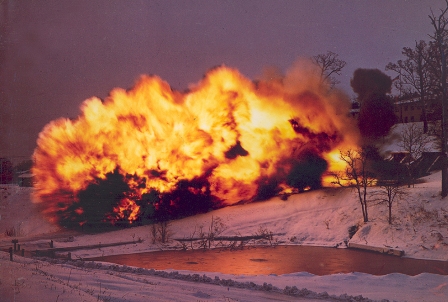Topics 6 & 16
 6 (
6 (
 7 h) & 16 (
7 h) & 16 ( 6 h) : Chemical kinetics
6 h) : Chemical kinetics
Introduction
 Most students will have come across the factors that affect the rate of a chemical reaction before they start the IB Diploma programme; however they tend to have only a superficial knowledge about the underlying explanations. At Standard Level the programme explains why concentration, temperature, surface area (see right) and adding a suitable catalyst can all affect the rate in terms of the collision theory and the Maxwell-Boltzmann distribution curves. Students are also expected to understand how the rate of reaction can be determined practically by a variety of different methods. At Higher Level the importance of the rate equation and the order of reaction are stressed and students are expected to be able to propose a reaction mechanism which is consistent with the rate equation. The effect of temperature on the rate constant and the use of the Arrhenius equation to determine activation energies are also included.
Most students will have come across the factors that affect the rate of a chemical reaction before they start the IB Diploma programme; however they tend to have only a superficial knowledge about the underlying explanations. At Standard Level the programme explains why concentration, temperature, surface area (see right) and adding a suitable catalyst can all affect the rate in terms of the collision theory and the Maxwell-Boltzmann distribution curves. Students are also expected to understand how the rate of reaction can be determined practically by a variety of different methods. At Higher Level the importance of the rate equation and the order of reaction are stressed and students are expected to be able to propose a reaction mechanism which is consistent with the rate equation. The effect of temperature on the rate constant and the use of the Arrhenius equation to determine activation energies are also included.
Some teaching points to consider
It is quite easy to relate Chemical kinetics to all the other ten topics during your teaching of Topics 6 & 16. Even so, Topic 6 & 16 is a relatively 'standalone' topic so it does not really matter where in the two year programme you teach it. In fact even though it is the sixth topic on the core programme most teachers tend to leave it until quite late in the second year for two main reasons. The first is that there is some mathematical understanding required so the more maths they do beforehand the better. The mathematical content has decreased in recent years. Prior to 1996 Higher Level students were required to be able to integrate the first and second order rate expression to obtain the integrated forms of the rate equations. This was so they could work out what graphs to plot in order to determine the order of reaction. This is now no longer on the syllabus. However Higher Level students are still required to understand how to use the logarithmic form of the Arrhenius equation to find the activation energy and even at Standard Level a knowledge of graphing techniques (see Topic 11) is required including being able to explain why the area under the Maxwell-Boltmann distribution curve remains constant at different temperatures. The second reason is that Chemical kinetics provides a wonderful opportunity to do much practical work. It not only includes one of the Mandatory laboratory components but also provides a rich area for students to consider for their individual scientific investigation. Kinetics experiments also provide an excellent opportunity to use data loggers and simulations. By leaving it until the second year students will be more familiar with experimental techniques and the assessment requirements.
The links on the left give you teaching tips etc. for each of the sub-topics together with questions and answers for each sub-topic.
Once you have finished teaching the whole topic you can give the multiple choice tests on Chemical kinetics (together with answers):
![]()
![]() Topic 6 Chemical kinetics
Topic 6 Chemical kinetics ![]()
![]() Topics 6 & 16 Chemical kinetics (1) and/or
Topics 6 & 16 Chemical kinetics (1) and/or ![]()
![]() Topics 6 & 16 Chemical kinetics (2)
Topics 6 & 16 Chemical kinetics (2)

 IB Docs (2) Team
IB Docs (2) Team